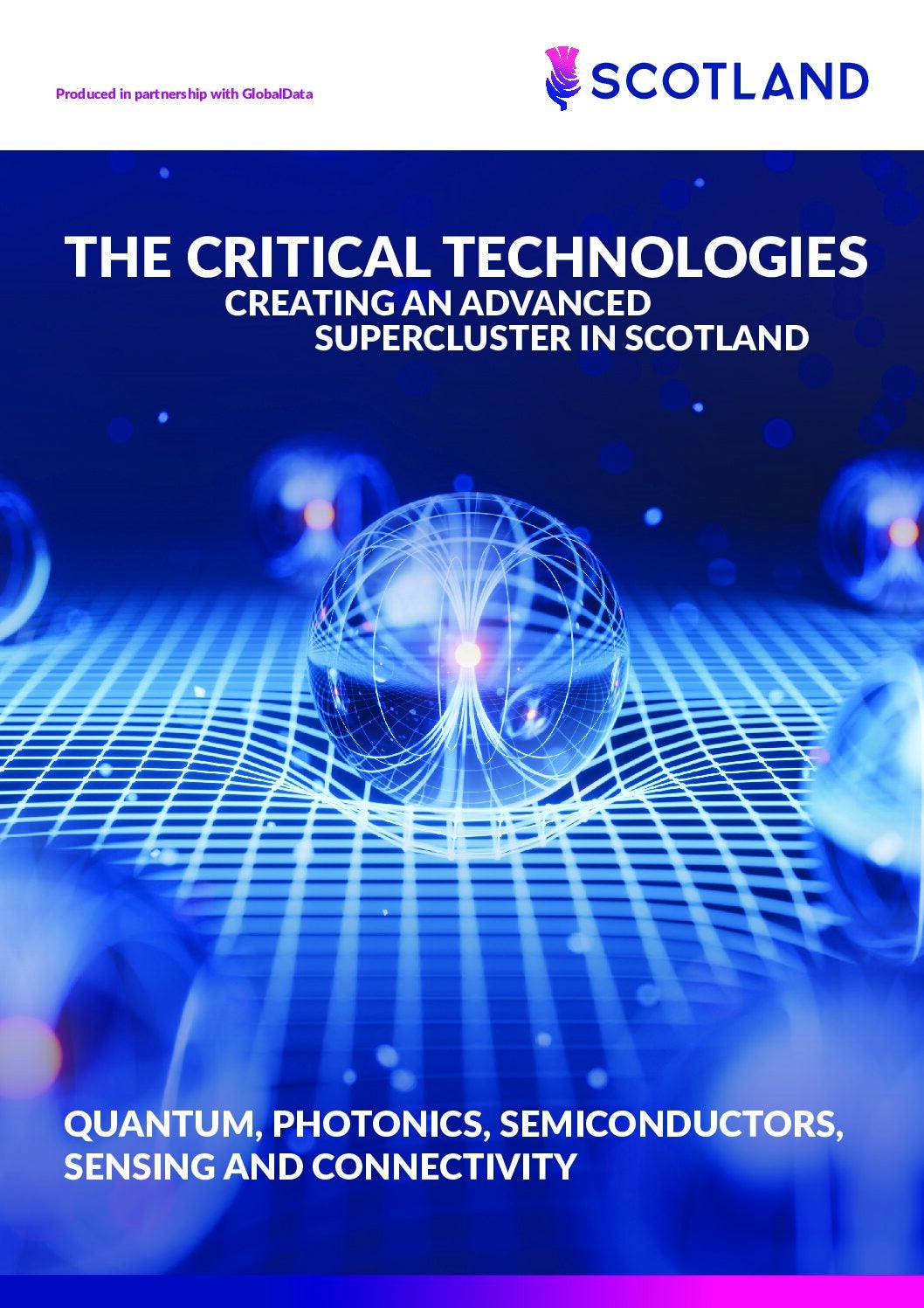
Quantum is predicted by many to be the next transformative technology, and Scotland is equipped to play a vital role in its development due to its strengths in photonics and semiconductor research.
The transformative powers of quantum have attracted considerable interest because of the sheer number of potential uses. The advanced capabilities could revolutionise operations in cybersecurity, drug discovery, navigation, and communications. However, the tech is still firmly in the research stages and there are few commercial solutions currently available.

Discover B2B Marketing That Performs
Combine business intelligence and editorial excellence to reach engaged professionals across 36 leading media platforms.
To advance the understanding of quantum capabilities, the UK Government announced £100m in funding for five new quantum research hubs in July 2024. Two of these hubs are in Scotland, with Scottish universities active in all five UK-wide. The UK Hub for Quantum Enabled Position, Navigation and Timing (QEPNT) is in Glasgow and the Integrated Quantum Networks (IQN) hub is in Edinburgh. Both are conducting groundbreaking studies, demonstrating quantum’s potential to improve online security and communications while overcoming challenges in scalability.
As a testament to the sector’s growing importance, quantum research was included in the Critical Technologies Supercluster industry initiative. The supercluster was announced in November 2024 and is backed by the Scottish Government and Scottish Enterprise to support the country’s world-leading technological output. With an ambition of a £10bn turnover by 2035, the supercluster is intended to strengthen both quantum research in a unique area of expertise and Scotland’s position as a leading destination for development.
Exploring the potential of quantum in Scotland
Despite accounting for only 8% of the UK’s population, Scotland has two out of the five hubs, highlighting the country’s academic and technical excellence in this field. The two quantum research hubs led by the University of Glasgow and Heriot-Watt University in Edinburgh are now up and running. Undertaking critical experiments to accelerate real-world applications of quantum technologies, the hubs also aim to generate interest among students of all ages – from primary school to PhD level.
A development that could radically upgrade online activity as we know it is in development at the UK Hub for Integrated Quantum Networks (IQN) Hub at Heriot-Watt. Led by Professor Gerald Buller, the team seeks to build the foundation of research required to establish a secure quantum internet for the UK. Formed of globally interlinked networks of multiple quantum computers, this new type of internet could provide far more secure and faster communications than existing networks dependent on satellites.
How quantum can establish more secure communications
Quantum technologies also have much potential in secure communications. To further these capabilities, the Edinburgh-based Heriot-Watt hub is researching quantum key distribution (QKD). This tech could replace existing public key encryption and render current cybersecurity methods nearly obsolete.
“Quantum processors can be used to decrypt public key encryption very effectively,” explains Buller. “There is a threat if the tech is exploited by bad actors. Part of the solution may well be the quantum networks we’re researching.”
Toshiba worked with BT to create the UK’s first commercial quantum secure network in 2020 and predicts that the global QKD market will be worth $20bn by 2035. By getting a head-start on research in this area, Scotland is well-positioned to take advantage of a predicted substantial international market.
Heriot-Watt’s flagship project is the Quantum Communications Hub Optical Ground Station (HOGS). This £2.5m advanced telescope will enable highly secure satellite-quantum communications. With a CubeSat scheduled for launch in October 2025, the facility’s cameras, sensors, and other photonic technologies form the only ground station of its kind in Scotland.
It is hoped that the hybrid satellite-quantum approach will help the research team overcome a major challenge in quantum development of amplifying signals over long distances.
“One thing you cannot do with a quantum signal is just amplify it the same way your telecommunications signals are amplified,” says Buller. “It’s a more complex process that involves quantum measurement and memory. With satellites, we can send quantum signals between continents.”
While the IQN Hub is addressing challenges with quantum memory and other technical challenges, the establishment of HOGS still represents a significant advancement in the field. The project stands at the intersection of a range of Scottish industries, with native expertise in quantum, satellites, and photonics all contributing to the success of the project.
Researching quantum-powered alternatives to GPS
Forty miles west, Scotland’s quantum centre in Glasgow is exploring how quantum-based positioning could transform navigation. The UK Hub for Quantum Enabled Position, Navigation and Timing (QEPNT) is researching the ways atomic clocks and LiDAR sensors could be deployed to overcome the flaws with GPS. Eliminating satellite jamming would improve the security of transport systems, as well as unlock smarter capabilities in autonomous vehicles (AVs).
“About £820bn of the UK economy is dependent on signals from satellites, including critical national infrastructure,” explains Professor Douglas Paul, Royal Academy of Engineering Chair in Emerging Technologies at the University of Glasgow and Principal Investigator of QEPNT. “But there’s a lot of GPS jamming going on around the UK, at a ridiculous level. The threat of electricity being blocked from your home or the internet going down is real and quite substantial.”
Vulnerability to external interference is not the only weakness of GPS systems. Satellite signals also fail navigation systems, with limited to no coverage in remote areas and underground.
“Network Rail loses trains every day,” Paul adds. “You might laugh and think: ‘Why don’t they know where a train is?’ That’s because they’re in tunnels and there’s no GPS to give them a position.”
With a quantum-based positioning system, navigating subterranean and submarine systems will be dramatically improved. Furthermore, the rollout of drones and self-driving cars could be accelerated through the integration of this technology. Quantum systems will be able to provide AVs with far more powerful powers of ‘sight’, including seeing 300m ahead in conditions with limited visibility such as fog, rain, or snow.
Driving quantum innovations in Scotland
Quantum has been recognised as a key industry for development in Scotland and was included in the Critical Technologies Supercluster announced by the Scottish Government in November 2024. Already worth £4.3bn and supporting 11,000 jobs across more than 150 companies, the ambition is to grow the supercluster’s revenues beyond £10bn and support a further 6,500 jobs by 2035.
Scotland’s expertise in the space and photonics industries is helping power the UK’s quantum plans, with all four universities in the Central Belt – Glasgow, Edinburgh, Heriot-Watt, and Strathclyde – participating in the five nationwide quantum hubs. The hubs complement the existing ecosystem of companies, facilities and universities in Scotland, offering a wide range of capabilities relevant to the quantum supply chain. This will support a wide range of future products from innovators around the world.
As a further commitment to collaboration, the universities of Strathclyde, Glasgow, and Heriot-Watt have joined together to create a centre for doctoral training in quantum. The impact of quantum will only be as significant as forecasted if a talent pool can grow with the technology. Initiatives at the Scottish Hubs aim to broaden the academic study of quantum from primary to postgraduate level.
“The IQN Hub is providing a pipeline of talent with over 20 research assistants and over 20 PhD students funded through the hub,” says Kevin McIver, business development manager at Heriot-Watt University. “Professor Buller is one of the leaders looking at summer schools and workshops for quantum networking. We are also developing a bespoke graduate apprenticeship for photonics, which will feed into developing quantum.”
“Part of our remit at IQN is outreach for younger people at a school level,” adds Buller. “You need a talent pipeline that starts right in schools, and I think quantum is something that young people can get excited about.”
With 40% of the quantum hubs based in Scotland, the nation continues to push the boundaries despite its relatively small size and deliver technological advances. Leading research undertaken at the IQN and QEPNT Hubs is just one example of the rich academic capabilities that continue to position Scotland as a world-leading research centre.
“Going back to the Enlightenment, Scotland has been punching above its weight in scientific research compared to its population,” says Paul. “We’re starting to see a lot of multinational companies and startups basing their businesses here because of the funding, the people, and the skills that are available.”
To learn more about the Critical Technologies Supercluster, download the document below.



